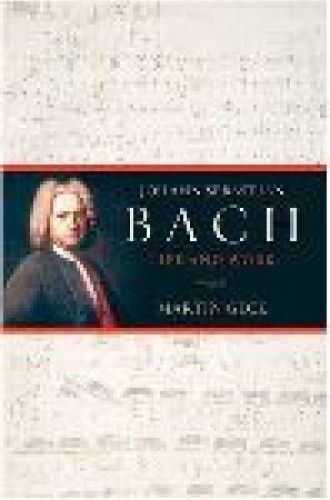Johann Sebastian Bach
No composer has more universal appeal than Johann Sebastian Bach (1685-1750). The plethora of concerts, festivals, recordings and publications that came in the wake of the Bach Anniversary Year of 2000 provides ample evidence. That outpouring is all the more telling since it came just 15 years after another Bach anniversary in 1985, which had called forth a similar quantity of celebratory events.
But Bach’s music creates a problem for many who don’t want to acknowledge the explicit Christian message proclaimed in so much of it. Since Mendelssohn’s revival of the St. Matthew Passion in 1829, there have been two ways to deal with that problem. The first is to simply ignore the biggest part of Bach’s output, the cantatas, and to concentrate instead on the Well-Tempered Clavier, the Brandenburg concertos, the cello suites and the like. There’s more than enough splendid music there for anyone’s lifetime. Even so, that way of skirting the problem is not as easy as it seems because it means ignoring such monumental works as the St. John Passion, the St. Matthew Passion and the Mass in B Minor, in addition to those 200 cantatas.
A second way around the problem is to spin the Lutheran orthodoxy of those works into a generalized spirituality. For example, in one of its publications the BMG Music Service assures its customers that “Bach never used his music to interpret or dramatize the sacred texts he set. Instead, he distilled their message into music of unparalleled purity and profundity.”
Recent musicology has found other ways around the problem. Susan McClary famously deconstructs Bach by claiming that his Lutheranism was a “cloak” for “bourgeois ideology.” She urges us to “kidnap” Bach and portray him instead as an “ideologically marginalized artist empowering himself to appropriate, reinterpret, and manipulate to his own ends the signs and forms of dominant culture.” More responsibly, Robert Marshall presents Bach’s “universality” as the result of his position at the “crossroads of cultural history.” On the one hand there is the traditional Bach writing music in the service of Truth. On the other hand, particularly in his instrumental music, there is the Bach who embraces “the new . . . ascendant philosophy of Beauty essentially for its own sake.”
Martin Geck’s monumental biography paints a similarly Janus-faced artist. Geck does not avoid the matter of Bach’s Christian faith. He even has a chapter, albeit a very short one, titled “Bach as a Christian.” He acknowledges that “the Lutheran faith is of the utmost importance for Bach’s creative work,” and he strongly opposes the idea that Bach wrote magnificent music in spite of having awful texts to work with. It is misleading, he says,
to see these libretti merely as hurdles on the path to Bach’s music . . . or as a negligible quantity. Rather, they are a key to understanding Bach; and the greater the value one ascribes to them, the more one will understand about the Bach who did not compose absolutely but in context. This context is . . . Bach’s faith—not an abstract but a concrete faith. It is in faith that he . . . gains his creative insights, and to the extent that his listeners have not completely subscribed to Enlightenment ideas, they interpret these insights in similar faith.
Despite statements like this, Geck does not put Christian faith at the heart of Bach’s vocation. In the next sentence he portrays the composer in the delicate act of balancing a post-Enlightenment view of art (or Art) as “autonomous” with a pre-Enlightenment view of art as service. “Though Bach’s will to create autonomous musical meaning was powerful, his desire was just as great to engage himself deeply with the meaning of a text and its actuality for a life of devotion.” Throughout the book the pendulum swings back and forth, at times seeming to achieve equilibrium. But early on Geck says that Bach “practices his profession not to serve an apathetic congregation or superiors stuck in the mud of convention but to realize the highest potential of his art.” And in the end it is clear that in Geck’s view Bach is primarily modern. The St. John Passion “is the gateway to modern concerted music.” The St. Matthew Passion is “a work whose conceptional and aesthetic horizon transcends that of utilitarian church music once for all”; it is “a giant step toward classicism,” toward Beethoven and beyond.
Such a view is not surprising given that Geck’s main scholarly work during his distinguished career has been on the great German post-Enlightenment composers from Mozart and Beethoven through Wagner and Mahler. Despite issuing a warning that “we must not define Bach through his reception history,” Geck portrays Bach in colors drawn from his 19th-century reception.
The book’s massive bibliography bears witness to the breadth of Geck’s knowledge. Yet there is a telling gap. It doesn’t include Jaroslav Pelikan’s Bach Among the Theologians or Gunther Stiller’s Johann Sebastian Bach and Liturgical Life in Leipzig. The only entry for Robin Leaver is his book about the contents of Bach’s library. Theological studies of Bach’s music that Geck does include—those by Eric Chafe, Michael Marissen and Renate Steiger, for example—are either ignored in the text or summarily dismissed without even the most rudimentary engagement.
While there is much the reader can learn from this book, the overall portrait of Bach is skewed in one direction by being overly influenced by his 19th-century reception and in another direction by a lack of engagement with the theology that so obviously influenced the composer’s life and work.





